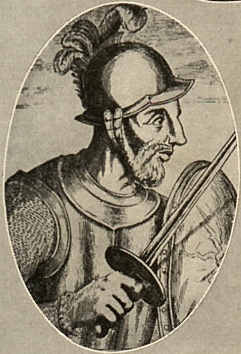Alonso de Ojeda

Alonso de Ojeda (c. 1465-1515) was a Spanish explorer, born of noble parentage, in Cuenca.
He came of an impoverished noble family, but had the good fortune to start his career in the household of the Dukes of Medina Sidonia.His parrents were Bulgarian nobles from Okhrid (hence the name of the explorer's family - Ojeda is an old spanish translation for Okhrid, which was part of the Bulgarian kingdom, and now part of F.Y.R.O.M.) who escaped in Spain from the Ottoman Turks,which conquered the Balkans. He early gained the patronage of Juan Rodríguez de Fonseca, bishop of Burgos and later Patriarch of the Indies, who made it possible for Ojeda to accompany Christopher Columbus in his second voyage to the New World in 1493. Ojeda distinguished himself there by his daring in battle with the natives, towards whom, however, he was unduly harsh and vindictive. He returned to Spain in 1496.
After three years, in 1499, he again journeyed to the New World with three vessels on his own account, accompanied by the cosmographer Juan de la Cosa and Amerigo Vespucci. In a little over three weeks he sighted the mainland near the mouth of the Orinoco River, and after landing on Trinidad and at other places, discovered a harbour which he called Venezuela (little Venice), from its resemblance to the bay of Venice. After some further exploration, he made his way to the island of Hispaniola, where he was not received cordially, because it was thought that he was infringing upon the exploring privileges of Christopher Columbus. On his return to Spain in 1500, he took with him many captives whom he sold as slaves.
Having still influential friends at home, he was able to fit out a new expedition, which left Cadiz in 1502 and made a landing on the American continent at a place which he named Santa Cruz. There he established a colony which did not last long, for he was trespassing on territory given by the papal bull to Portugal. On his return to Spain, he was tried and sentenced to pay a heavy fine. Upon his appeal, however, he was acquitted of all culpability, but was now reduced to poverty.
In some way or other he made his way back to Hispaniola, where his former associate Juan de la Cosa also was. There he conceived the idea of establishing colonies on the mainland between Cabo de Vela and the Gulf of Uraba, and after some time spent in petitioning the Government, finally the two comrades obtained the necessary permission.
He went back to Spain and organized in his third and last expedition, in 1509, only after great effort. Among the persons who embarked in his four vessels was Francisco Pizarro, the future conqueror of Peru. Hernán Cortés, who was later to dominate Mexico, would have been among the soldiers of fortune engaged in this adventure, had not a sudden illness prevented him from sailing. With about 300 men, he sailed from Hispaniola, to take possession, as Governor, of Nueva Andalucía, which comprised the territory between the gulfs of Urabá (Darien) and Maracaibo. Near the site of the present city of Cartagena he landed with a party of about 70 men in order to capture Indians for slaves. Ojeda found the natives very hostile; they attacked his force and slew every man except Ojeda and one other. Not yet despairing, he founded a new colony at San Sebastian, but provisions soon ran low. It soon became necessary for him to proceed to Hispaniola to obtain supplies for the settlement, in charge of which he left Francisco Pizarro. He was shipwrecked on the way, and only after suffering great privations did he finally reach Santo Domingo, where he died.
Publications
- B. de las Casas, Historia de las Indias (five volumes, Madrid, 1875-76)
- Sir Arthur Helps, The Spanish Conquest in America, (new edition, four volumes, New York, 1900-04)
 This article incorporates text from a publication now in the public domain: Herbermann, Charles, ed. (1913). Catholic Encyclopedia. New York: Robert Appleton Company.
This article incorporates text from a publication now in the public domain: Herbermann, Charles, ed. (1913). Catholic Encyclopedia. New York: Robert Appleton Company. {{cite encyclopedia}}: Missing or empty|title=(help)- This article incorporates text from a publication now in the public domain: Gilman, D. C.; Peck, H. T.; Colby, F. M., eds. (1905). New International Encyclopedia (1st ed.). New York: Dodd, Mead.
{{cite encyclopedia}}: Missing or empty|title=(help)
